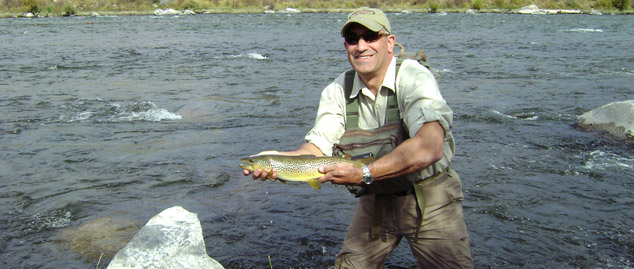Check Out
Fly-fishing Expert Shares His Passion and Wisdom

Question: What is the hardest thing for beginners to learn?
Paul Scott: It seems to depend on their experience with other kinds of fishing. But even if someone is an accomplished fisher in other methods such as spinning gear, the hardest thing at first is usually fly-casting. After that, line management seems to present challenges, and beginners can feel like they're doing the Watusi in a giant bowl of spaghetti. Line management is important because many flies need to be presented drag-free, that is, drifting naturally and not appearing to be tethered to a line. This isn't an issue with other forms of fishing where you just cast out and reel back, and as a result it often presents a challenge for beginners. Also, most people have to learn the hard way how to wade carefully and beginners seem to barge into fishing spots, make tons of noise, and cast repeatedly until the water is beaten to a froth, then leave frustrated. They might have had the right fly selected, but spooked fish are impossible to catch.
Q: Is fly-fishing more difficult to master than golf in terms of technique?
PS: I don't play golf so it's hard for me to say but my fishing friends who golf describe it as quite a challenge. Both obviously take lots of practice and patience to master. Interestingly, sports like golf, tennis, etc, encourage you to 'swing through' the ball, but with fly-casting there is a need for a definitive check of the cast (or 'swing') to allow the rod to 'unload' and cast the line. The ability to give the rod a chance to unload usually takes work for golfers and tennis players. I have a friend who says about golf “drive for show, putt for dough.” The same could be said about fly-casting, as the photos in the magazines often show these long elegant casts, which are great, but most fishing situations demand accuracy instead of raw distance. With golf, if you miss a put, the hole doesn't go anywhere and you can just walk up and finish the putt. With fly-fishing, if you blow your cast to a wary fish, they'll either spook or just lock up, sort of like missing a putt and having the hole disappear --you just have to move to another hole!
Q: As an Orvis guide and instructor for many years, what are some other common mistakes you've seen neophytes doing?
PS: Simply put, many beginners usually don't practice their casting and knot tying enough and once they go fishing this can cost them valuable opportunities and certainly a lot of time. Many beginners think that a long cast is needed, when in fact getting as close to the fish as you can without spooking them is a critical skill, and it keeps the casts short and manageable. Often you only get one shot at a fish, and you really need to make it a good one. Casting over and over to try and get the perfect cast is counterproductive; it's far better to make a good accurate cast the first time. Beginners might like to practice their technique with pan fish which are those typically found in large rivers, lakes, and farm ponds and include bass, bluegill, bream, perch, crappie. The focus should be on learning how to approach fish quietly and to remain undetected. Gear and distance casting are secondary issues. All the best gear and the right fly won't help you catch a spooked fish. Spend less and fish more.
Q: What is the proper etiquette for someone in a stream with other anglers?
PS: It can vary by location and size of the crowd. What is acceptable on opening day of trout season in
Q: What is the difference between fishing in the sea and in the river? Do trout and salmon behave differently than their salt-water brethren?
PS: Depending on where you're fishing the sea, it can be very similar to fishing rivers, and in my area (the Tidewater area of Virginia's Chesapeake Bay region), it's virtually identical --fish will orient on current seams, where two different currents collide, often forming a seam where fish can sit in the slower current, while waiting to feed on current coming along in the faster current; or choose structures such as rocks, weed beds, logs, which slow down the current flow and allow them to sit in the slower water while watching for food to appear in the faster water. They will behave in much the same way you'd expect from their freshwater cousins. The open ocean is a different animal all together, and it's best learned with a professional, but very often even tuna, marlin, sailfish, wahoo. and dolphin will orient on current seams, temperature breaks, and sunken structures like reefs, ship wrecks, and sea mounts which are underwater mountains. All fish will try to maximize the ratio of energy spent eating and energy gained eating, and they will all look for current breaks or structure that will allow them to lie in more or less an ambush position. Salmon are on a different mission and may not strike flies to feed, but out of aggression or territorial defensiveness. Trout are in the salmon family and they also they spawn, but the trout that live in small rivers don't make those grand spawning runs like people traditionally think of salmon doing; they spawn right where they spend most of their lives. In the Tidewater area of
Q: What are your favorite places in the
PS: I've never met a fish I didn't like anywhere in the
Q: How does drought or pollution affect fishing conditions?
PS: Trout can survive drought if the water doesn't get too hot, but when it gets low and hot, many fish will perish. Acid rain causes heavy metals to go into solution, allowing it to coat fishes gills, killing them slowly. Silt, caused by poor logging practices and development, covers up spawning beds and kills off the invertebrate food base. We now understand that certain types of pollutants, such as fertilizers coming from golf courses hundreds of miles up the tidal rivers that feed the
Q: Have you noticed a decline in fishing populations at your regular haunts?
PS: I've seen native fish populations decline in western
Q: What is the best way to outsmart trout?
PS: The best way to outsmart trout is to first not scare it to death, then try to get a fly in front of it that it'll be willing to check out. It all sounds so easy! Amazingly, trout can be very sensitive to shades of color, and even refuse a fly tied onto leader material 0.006" thick, but will take the same fly tied on material 0.005" thick. The most cunning trout are usually wild fish (versus stocked or hatchery-raised fish), with wild browns seeming to be a little more picky than other species.
Q: What do you recommend for gear-- rod, reel, line, wading gear?
PS: Get good, versatile gear that will last a while, but don't break the bank on the hottest new thing. You can't buy practice, so save a little money on gear, and spend the rest to get more time on the water either by investing in a guide, or in gas to drive to a good spot. As a guide, nothing used to give me heartburn more than someone showing up with thousands of dollars worth of brand new gear that he hasn't practiced with. I'd rather have the guy with the $200 outfit who has practiced with it enough that can hit a pie plate at twenty yards ninety percent of the time. Consistent success depends on one’s ability to hit a target, and pretty gear doesn't help one do that. Practice does. That is why beginners should start by identifying what kind of fishing they will be doing most of the time, and make gear decisions from there. Most fly-fishing retailers appreciate it when you let them know what you can and want to spend, and they'll find an outfit that's appropriate for what you want to do.
Q: What do you like best about RailRiders apparel?
PS: What's not to like! It's tougher than a giant bluefish, and the stitching and seams are very high quality. The gear is both functional and great looking. I have worn my RailRiders gear pretty hard, washed it repeatedly, and have been very impressed with its durability, especially the reinforced knee and seats. For fishing, it's also great that the material dries so quickly.
Q: What was the biggest fish you caught and where?
PS: The biggest fish I caught was probably a seven-foot lemon shark in
Q: What do you like most about fly-fishing? Is it an art, science, or religion?
PS: I love everything about it, especially the life-long aspect of it. One of my favorite writers, John Gierach, said, “I think I fish, in part, because it's an anti-social, bohemian business that, when gone about properly, puts you forever outside the mainstream culture without actually landing you in an institution.”
Q: Do you do any other outdoor activities?
PS: I love mountain biking, stand-up paddle boarding, surfing, kayak fishing, and I do lots of hunting (spring turkey and deer), and am fanatic about morel mushroom hunting. I brew my own beer, wine, and mead, and usually do that outdoors, but I'm not sure if that counts. I've got quite an organic garden going this year including three varieties of beer hops.


